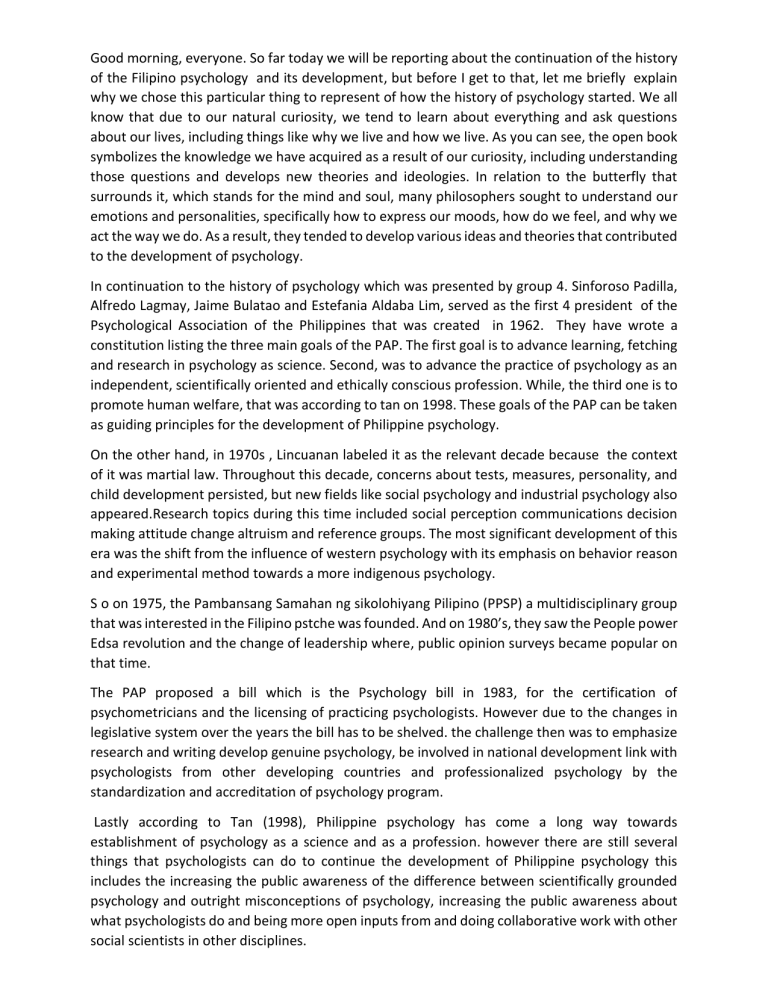
Good morning, everyone. So far today we will be reporting about the continuation of the history of the Filipino psychology and its development, but before I get to that, let me briefly explain why we chose this particular thing to represent of how the history of psychology started. We all know that due to our natural curiosity, we tend to learn about everything and ask questions about our lives, including things like why we live and how we live. As you can see, the open book symbolizes the knowledge we have acquired as a result of our curiosity, including understanding those questions and develops new theories and ideologies. In relation to the butterfly that surrounds it, which stands for the mind and soul, many philosophers sought to understand our emotions and personalities, specifically how to express our moods, how do we feel, and why we act the way we do. As a result, they tended to develop various ideas and theories that contributed to the development of psychology. In continuation to the history of psychology which was presented by group 4. Sinforoso Padilla, Alfredo Lagmay, Jaime Bulatao and Estefania Aldaba Lim, served as the first 4 president of the Psychological Association of the Philippines that was created in 1962. They have wrote a constitution listing the three main goals of the PAP. The first goal is to advance learning, fetching and research in psychology as science. Second, was to advance the practice of psychology as an independent, scientifically oriented and ethically conscious profession. While, the third one is to promote human welfare, that was according to tan on 1998. These goals of the PAP can be taken as guiding principles for the development of Philippine psychology. On the other hand, in 1970s , Lincuanan labeled it as the relevant decade because the context of it was martial law. Throughout this decade, concerns about tests, measures, personality, and child development persisted, but new fields like social psychology and industrial psychology also appeared.Research topics during this time included social perception communications decision making attitude change altruism and reference groups. The most significant development of this era was the shift from the influence of western psychology with its emphasis on behavior reason and experimental method towards a more indigenous psychology. S o on 1975, the Pambansang Samahan ng sikolohiyang Pilipino (PPSP) a multidisciplinary group that was interested in the Filipino pstche was founded. And on 1980’s, they saw the People power Edsa revolution and the change of leadership where, public opinion surveys became popular on that time. The PAP proposed a bill which is the Psychology bill in 1983, for the certification of psychometricians and the licensing of practicing psychologists. However due to the changes in legislative system over the years the bill has to be shelved. the challenge then was to emphasize research and writing develop genuine psychology, be involved in national development link with psychologists from other developing countries and professionalized psychology by the standardization and accreditation of psychology program. Lastly according to Tan (1998), Philippine psychology has come a long way towards establishment of psychology as a science and as a profession. however there are still several things that psychologists can do to continue the development of Philippine psychology this includes the increasing the public awareness of the difference between scientifically grounded psychology and outright misconceptions of psychology, increasing the public awareness about what psychologists do and being more open inputs from and doing collaborative work with other social scientists in other disciplines.





